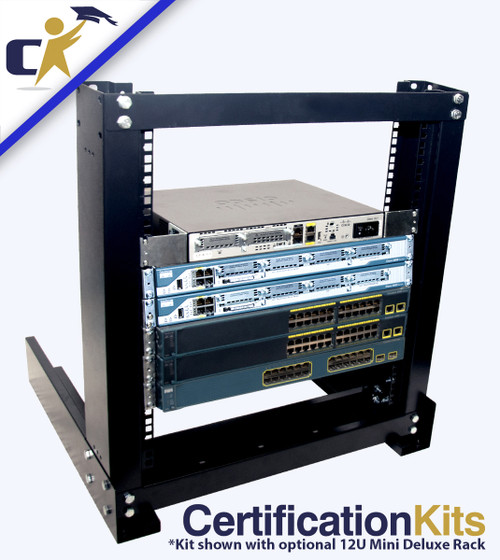Cisco CCNA 200-301 How & Why We Subnet Workbook IPV4-IPv6
Desktop & Mobile Compatible! IOS & Android friendly!
Over many revisions we have seen thousands of candidates take the CCNA exam. Time after time we come to the same conclusion on the number one reason that even the most prepared candidates do not pass. The reason is very simple... They run out of time!
The biggest place that we have found that time is lost on the actual CCNA exam is on the subnetting questions, when the majority of your time should be spent on the more difficult configuration questions. For this reason, we decided to build the ultimate Subnetting Workbook to get you up to speed on manual subnetting and blow right through these tedious questions! Our subnetting methods have proven themselves to work through generations of CCNA success stories. This is our best revision yet and this time we even raised the bar by including our brand new IPv6 section. This will prepare you for any curve-balls Cisco may throw you on the exam and have you one step ahead for the real world.
Not only does this guide provide you with tons of practice questions, scenarios and answers, but also builds a firm foundation and understanding of how and why you subnet.
This 120 page workbook was designed to walk you through the theory of subnetting partnered with enough sample and practice scenarios to have you mastering subnetting in no time. Armed with the knowledge and practice in the eBook, you won't miss a single subnetting question on your CCNA 200-301 exam! Subnetting is the most heavily hit concept on the CCNA Routing & Switching 200-301 exam and there is no magical calculator allowed, so make sure you are prepared by fully mastering the skill of subnetting.
With this release, we even took things a step further by upgrading to our new awesome eBook reader through LockLizard. This is the same engine that Cisco actually uses to protect and distribute their corporate documents. This makes it extra cool because it is a format you will see in the field as a working network engineer. This new ebook reader works on multiple platforms such as PC, MAC, IOS, Android, etc. We include 2 activations with each purchase so you can install it on a desktop AND a mobile device, for example. On top of that you can highlight, make notes and work directly with your document.
Since this is a workbook, we also allow you to print one copy yourself per license so you can follow along on paper if you wish!
Please feel free to check out a demo of the first chapter of this ebook:
1. Download and install the LockLizard viewer for your IOS and device type from this link: LockLizard Viewer
2. Download and install the License file for the eBook: License File
(If you don't see it open, the window for the license file may pop-up behind your active windows)
3, Download and open the .Pdc eBook file: eBook File
The download and install is very straightforward and simple, but if you get stuck, please click here for a help guide on opening your eBook demo or official purchase. Upon purchase a unique license file and a .pdc file will be emailed to you,
Let's take a look at the concepts and practice exercises covered in this CCNA R&S 200-301 Subnetting Lab Workbook.
Chapter 1
- What are IP Addresses and why do we need them?
- The Internet
- IP Addresses
- Format of IP Addresses
- Understanding Binary
- Converting form Binary to Decimal
- Converting from Decimal to Binary
- IP Address Conversion – Decimal to Binary
- IP Addresses Conversion - Binary to Decimal
- Exercise 1.1: Binary to Decimal Practice
- Exercise 1.2: Decimal to Binary Practice
Chapter 2
- Subnets – What Are They & Why Do We Need Them?
- Introduction
- Media Access Control (MAC)
- Network IDs & Host IDs
- Exercise 2.1: Determining the Network ID ANDing Practice
- Finding the Network Address
- Exercise 2.2: Finding the Subnet the Address Resides On
Chapter 3
VLSM – Subnetting Without Being Wasteful!
Calculating the Number of Valid Subnets
Exercise 3.1: Determining the Number of Valid Subnets for Class A Addresses Practice
Exercise 3.2: Determining the Number of Valid Subnets for Class B Addresses Practice
Exercise 3.3: Determining the Number of Valid Subnets for Class C Addresses Practice
Finding the Number of Valid Hosts
The Block Method – Subnetting for Speed!
Exercise 3.4: Finding the Number of Valid Hosts
Exercise 3.5: Choosing the Appropriate Subnet Mask
Exercise 3.6: Finding the Network ID, Broadcast Address, Address and Valid Address Ranges
Exercise 3:7: Subnetting for Speed!
Route Summarization
Exercise 3.8: Determining Correct Masks for Summarization
Chapter 4
- Meeting the Stated Design Requirements
- Scenarios
- Exercise 4:1: Meeting the Stated Design with the Appropriate Subnet Mask
Chapter 5
- Finite Address Space and NAT
- Conserving IP Addresses
- Network Address Translation (NAT)
- Dynamic NAT
- NAT Overload
- Chapter 6
- IPv6
Ipv6 Address Representation
- Network and Interface IDs
- IPv6 Global Unicast Address (GUA) Structure
- Subnetting an IPv6 Network
- Types of IPv6 Addresses
- Exercise 6:1: Reduce the IPv6 addresses to their shortest form
- Exercise 6:2: Identify the Interface ID
- Exercise 6:3: Identify the Global Routing Prefix and the Subnet ID
- Exercise 6:4: Basic IPv6 Subnetting Problems








